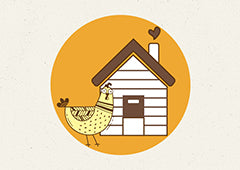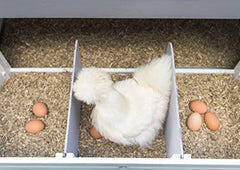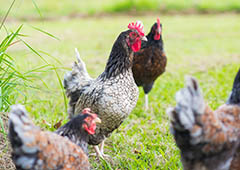One of the most popular questions first time chicken owners ask is, “which breed of chooks are the best laying hens?” Some first time owners are surprised to hear that there are different breeds of chickens, let alone particular breeds that lay eggs more prolifically than other varieties. Though it might seem as though there is a lot of learn, it’s all actually pretty simple stuff. Here is an essential rundown for poultry keepers who are looking for the most productive laying hens available.
But first…
No matter what breed of laying hens you get, quantity and quality of eggs all depend on your chickens leading happy lives with excellent nutrition. Have a read about everything you can do to ensure your laying hens produce lots of eggs here.
Isa Brown
Isa browns are adorable and affectionate little feathered friends that can produce up to a whopping 300-350 eggs per year! These American bred girls are really in a league of their own when it comes to egg production, and many of them start to lay as soon as 16 weeks! They weigh approximately 4.5-5.8 kg, which is quite heavy for your standard laying hen. Perhaps it is their robust size that attribute to their strong egg-laying ability? They’re reasonably low-maintenance and adapt easily to all kinds of climates, be it cool, warm or otherwise, so you can be sure they will make themselves right at home in your backyard. Want to know more? Check out our 5 reasons to love Isa Browns here! Or, better yet, I highly recommend the extensive online courses at Chickenpedia which will walk you through how to choose and compare chicken breeds.
Rhode Island Red
The Rhode Island Red is one of the world’s most famous breeds of laying hens. The breed was designed specifically to suit the needs of humans in a farm out in the Compton district, Rhode Island. The breed quickly became a popular staple in many farms due to their attractive appearance and superior laying ability, producing approximately 250-300 eggs per year. They’re known for their attractive deep red plumage, which should have a slightly salmon colour when inspecting the under-fluff. These chickens are especially easy-going and are suitable for anyone who is looking for a non-fuss kind of laying hen. Want to know more? Check out our 5 reasons to love Rhode Island Reds here!
Australorp
The Australian bred Australorp has been adapted from the British black Orpington to be a more productive and practical poultry breed. Originally, the Australorp was very practically titled ‘Australian Utility Black Orpington’, however the name was quickly abbreviated to what we know today. Australorps are great layers, averaging 250-300 eggs per year, of a light brown variety. These beautiful and docile black poultry birds with a beetle green tinge, weigh between 3-4 kg and prefer environments in which they have more space to free-range. Want to know more? Check out our 5 reasons to love Australorps here! Or, better yet, I highly recommend the extensive online courses at Chickenpedia which will walk you through how to choose and compare chicken breeds.
Leghorn
The Leghorn takes its name from a port in Italy, also known as Leghorn. For many hundreds of years the Leghorn was renowned for being one of the best laying hens available. When exported out to the Californian town Petaluma, the town made huge profits from their egg industry built on the backbone of Leghorns and they declared their first Annual Egg Day in 1916 the celebrate this fabulous bird. These active and seldom broody birds weigh approximately 2.5-3.5 kg and produce between 280-320 eggs per year. There are many different varieties of Leghorn available with an assortment of different coloured plumage.
Plymouth Rock
Plymouth Rock is an American breed of chicken, which began its life in infamy, before becoming a worldwide popular choice of laying hens. Originally the breed was considered a tacky mongrel, as its genetic code comprises of a wide variety of breeds, however their heavy productivity (200-250 eggs per year), and their ability to lay throughout winter has made them a popular choice for many poultry keepers. They come in a range of different varieties, from barred, to white, buff, silver pencilled, partridge, blue and black. Want to know more? Check out our 5 reasons to love Plymouth Rocks here! Or, better yet, I highly recommend the extensive online courses at Chickenpedia which will walk you through how to choose and compare chicken breeds.
Sussex
The Sussex is a famous British breed of chicken that nearly died out in the early 20th century, if it were not for one farmer, who had the last remaining flock of Sussex chickens, which he had been breeding for ten years. These beautiful birds weigh approximately 3-4 kg and produce between 200-350 eggs annually. They are confident, curious and friendly laying hens that come in a vast array of spectacular varieties, such as buff, speckled and white, just to name a few.
Welsummer
The Welsummer is a remarkably attractive breed of laying hen that was created in the Netherlands at the beginning of the 20th century in a town known as Welsum- which is of course where it borrows its name from. Many poultry aficionados refer to it as the “perfect looking chicken”. This is in large part due to its glossy feathers, high tail and attractive shape. Additionally, these in-demand birds also produce upwards of 160 terracotta coloured eggs each year. They are active and alert foragers that need plenty of stimulation otherwise their energies will turn towards more destructive behaviours.
Wyandotte
The Wyandotte is a hardy, robust, no-nonsense kind of laying hen. They were bred by Americans in the 19th century to be an attractive and sturdy yet practical bird and they have become just that. The Wyandotte laying hen is both popular with backyard poultry keepers, as well as those chicken gurus who partake in the competitive world of poultry shows. These birds come in a range of different colours, weigh between 2.7-3.8 kg and produce around 200 eggs per year.
There is so much to consider before choosing your chooks. When deciding on the egg-layers you want, the options can be eggstremely overwhelming. From egg size, colour to production rate - where should you begin?
Cluckily, our friends over at Chickenpedia have created an amazing Chicken Breeds Course. This extensive online course shares helpful guidance on choosing the top chickens for you as well as size & frequency of eggs laid. You will even learn about their distinct personalities, and be able to use their family-friendly compatibility scale through this well-structured program. It really is a great way to discover your perfect backyard buddies which is why I highly recommend them to all of my readers! The courses are beginner-friendly and filled with essential information to help you raise a happy, healthy flock.
We all want to do an eggcellent job when caring for our feathered friends. Many keepers struggle to handle chicken health or behaviour issues, especially in the first few years of having a flock. Chickenpedia have a broad range of comprehensive online courses that cover everything you didn’t know you need to know and then some more! From healthcare to raising baby chicks to feeding and behavior, get the knowledge and confidence to successfully look after your flock.
As a member, you will get access to ALL their fantastic courses. So, no need to wing it, become a confident chicken keeper. Click here to check out Chickenpedia today!
There are so many unique qualities that each different breed of laying hens possess. Many owners find themselves keeping a wide range of chickens, and not just laying hens- some people like oddball combinations like Isa Browns, with Silkie chickens and maybe a Jersey Giant and Australorp thrown into the mix as well. Don’t feel limited to just one type of chicken, be it a good laying hen or otherwise. Diversify your Taj Mahal, Penthouse or Mansion coop with the most interesting varieties of chooks available.
If you're ever worried that your hens may have stopped laying, be sure to read this very informative article here.

























